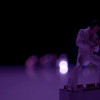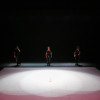AND THE COLORED GIRLS SAY: DOO DA DOO DA DOO DA DOO (2018)
Idea and choreography Elisabetta Consonni Performance Daniele Pennati, Masako Matsushita, Elisabetta Consonni, Susanna Iheme Assintant at choreography Francesco Dalmasso Light Design Irene Innocenti, Maria Virzì Sound Fabrizio Saiu Costumes Indetail/Lucia Sandrini Vocal Coach Chiara Osella Production Teatro Grande di Brescia, Aiep-Ariella Vidach With the support of Zona K, Ilinx, theWorkRoom-Fattoria Vittadini.
[ita below]
And The Colored Girls Say: Doo Da Doo Da Doo is a choreographic investigation of the stage margin as a metaphor for the social margin. Inspired by the reflections of the activist and writer bell hooks and staging the anonymity of background singers in American musical pop culture, it unfolds as a chiaroscuro of bodies and voices in the shadow of the limelight. It is a concert of unsung voices, of second voices, extras and backgrounds. It is a show without the star, it is what is around the object in focus in a picture, it is the white around the written words. It is everything that lies beyond a margin line and is not allowed to enter the bright zone of the limelight.
You need a precise intention to distinguish the background singers' choruses of a song and isolate them from the main voice, as well as to notice the backgrounds and everything around an object placed in the centre where our attention is directed. It is essential to activate what the architect Juhani Pallasmaa calls peripheral vision, a natural ability of each of us but weakened by a centuries of education in perspective vision directed towards a hegemonic centre to which we direct our attention. It is this peripheral vision that makes us notice those who stand on the edge, those who are forced to cultivate their horizons within the circumscribed limits of small movements, to respect established rhythms, those who are forced to remain secondary elements, counterparts to other protagonists, accessories, periphery.
It is from that position that Bell Hooks draws attention to the space she inhabit and "explores the silences" of a community of "broken voices" struggling to find "their true voice". "Living in this way -at the extreme- we have developed a particular look at the world. Looking from the outside in and vice versa, we have focused our attention as much on the centre as on the edge", which becomes a space "able to offer us the possibility of a radical perspective from which to look, create, imagine alternatives and new worlds".
It is in that margin that a generative humanity lives. And the colored girls say: doo da doo da doo da doo (from Walking on the wild side by Lou Reed) is a declaration of love towards all this. It is a "Praise of the margin".
"Who has ever bothered to find out who are the singers who sing the chorus just a few metres away from the star?" "Singing fragments of a song like Freedom, the fiercely ironic title for a condition of perennial subalternity" (Bresciaoggi).
[...] Elisabetta Consonni overturns the hierarchies of power. She offers a chance to marginality, which expresses its charisma and talent in a peripheral space, where isolated figures find that bit of centrality thanks to alliances, fun and solidarity [...]. It is not true that when you don't appear you don't exist: on the contrary, you exist more intensely [...]. In this eccentric and amusing work, Consonni issues a warning of authenticity and humility that is fundamental in the age of social media, where appearances count and being is often a lie. "(Krapps' Last Post, Vincenzo Sardelli)
****************
And The Colored Girls Say: Doo Da Doo Da Doo Da Doo è un’indagine coreografica sul margine scenico come metafora del margine sociale. Ispirandosi alle riflessioni della saggista militante bell hooks e mettendo in scena l’anonimato delle coriste background nella cultura pop musicale americana, si delinea come un chiaroscuro di corpi e di voci all’ombra della ribalta. È un concerto di voci non in capitolo, di seconde voci, comparse e sfondi. È uno show senza la star, è quello che sta attorno all'oggetto messo a fuoco in un’immagine, è il bianco attorno alle parole scritte. È tutto quello che sta oltre una linea di margine e a cui non è dato entrare nella luminosa zona delle luci della ribalta.
È necessaria un’intenzione precisa per distinguere i cori delle cantanti background di una canzone e isolarli dalla voce principale, così come per notare gli sfondi e tutto ciò che sta attorno ad un oggetto posto al centro e su cui si rivolge la nostra attenzione. È indispensabile attivare quella che l’architetto Juhani Pallasmaa chiama visione periferica, abilità naturale di ciascuno di noi, impigrita però da una secolare educazione alla vista prospettica indirizzata verso un centro-punto di fuga egemonico a cui viene diretta la nostra attenzione. È questa visione periferica che ci fa notare chi sta al margine, chi è costretto a coltivare il proprio orizzonte nel limite circoscritto di piccoli movimenti, a rispettare ritmi stabiliti, chi è costretto a restare elemento secondario, controparte di altri protagonisti, accessorio, periferia.
È da quella posizione che bell hooks porta l’attenzione sullo spazio che le è dato abitare in quanto donna nera ed “esplora i silenzi” di una comunità di “voci spezzate” in lotta per trovare la “propria vera voce”. “Vivendo in questo modo -all’estremità- abbiamo sviluppato uno sguardo particolare sul mondo. Guardando dall’esterno verso l’interno e viceversa, abbiamo concentrato la nostra attenzione tanto sul centro quanto sul margine”, che diventa spazio “in grado di offrirci la possibilità di una prospettiva radicale da cui guardare, creare, immaginare alternative e nuovi mondi”.
È in quel margine che vive un’umanità generativa. And The Colored Girls Say: Doo Da Doo Da Doo Da Doo (da Walking on the wild side di Lou Reed) è una dichiarazione d’amore verso tutto questo. È un “Elogio del margine”.«Chi si è mai dato pena di sapere chi siano le cantanti che intonano il coretto a pochi metri di distanza dalla star?» « Cantando frammenti di una canzone come Freedom titolo quanto mai ferocemente ironico per una condizione di perenne subalternità» (Bresciaoggi).
“[...] Elisabetta Consonni ribalta le gerarchie di potere. Offre una chance alla marginalità, che esprime il proprio carisma e talento in uno spazio periferico, dove figure isolate trovano quel po’ di centralità grazie ad alleanze, divertimento e solidarietà. Non è vero che quando non si appare non si esiste: anzi si esiste più intensamente[...]. In questo eccentrico e divertente lavoro, Consonni lancia un monito di autenticità e umiltà fondamentale nell’era dei social, dove conta l’apparire e l’essere è spesso menzogna. “ (Krapps’ Last Post, Vincenzo Sardelli)
TOUR
2021 Danae Festival, Milano (IT)
2018 Festival la Democrazia del Corpo, Firenze (IT)
2018 Premiere: Teatro Grande di Brescia, (IT)
2017 Finalist project at Cross Award, Verbania (IT) with the studio AiLatidItalia
2016 Winning project of DNA- Appunti coreografici with the studio AiLatidItalia




